|
IUCN/SCC Otter Specialist Group Bulletin
©IUCN/SCC Otter Specialist Group
Volume 24 Pages 1 - 76 (December 2007)
Citation: Georgiev, D. (2007)Otter (Lutra Lutra L.) Mortalities In Southern Bulgaria: A Case Study. IUCN Otter Spec.
Group Bull. 24 (1): 36 - 40
Previous | Contents
| Next
Otter (Lutra Lutra L.) Mortalities In Southern Bulgaria: A Case Study.
Dilian Georgiev 1
1
Department of Ecology and Environmental conservation, University of Plovdiv, Tzar Asen Str. 24, BG-4000 Plovdiv, Bulgaria
e-mail: diliangeorgiev@abv.bg |
 |
|
Abstract:Otter mortalities (n = 50) from Southern Bulgaria were analyzed. Among the mortality types, poaching was the most common cause of death recorded in this study (52% of all mortalities recorded), followed by road kill (10%) and drowning (8%). Killing of otters by dogs had the lowest impact (6%).
Most of the otter mortalities (40%) came from areas with fish-farming activities – micro-dams and fishponds. In the second place were the regions of the large dams with 18% of all otter mortalities. The other locations provided lesser numbers of otter deaths. |
| Française | Español |
INTRODUCTION
The Eurasian otter (Lutra lutra L.) has been protected in Bulgaria by law since 1962. It has a relatively stable population and is widely distributed in the plains, but is scarce in the high mountains and in the steppe regions of the north-eastern part of the country (Spiridinov and Spassov, 1989; Georgiev, 2005). After a change of political regime in 1989, the number of otters increased from 800 - 1200 adult and subadult individuals in the period 1977-1989 (Spiridinov and Spassov, 1989) and 1000 – 1400 in 1989-1994 (Spiridinov and Mileva, 1994) to 2300 – 2400 calculated in 2006 (Georgiev and Koshev, 2006, unpublished). Spiridinov and Spassov (1989) recommend a study on the threats to otters in Bulgaria, and accordingly in this paper we represent some data on some otter mortalities, gathered in the south of the country.
MATERIALS AND METHODS
Data were gathered mainly during 2005 and 2006 from 34 locations in Southern Bulgaria (Figure 1). Otter mortalities were investigated by questioning various people: biologists, fish-farmers, hunters and others. When it was possible carcasses were collected and pictures were taken. Otter mortalities (n = 50) were divided into the following types: poaching (killed by guns or various traps), drowning (nets, fyke nets), road kill, killed by dogs, collection of specimens (possession of otters or their derivatives, e.g. pelts, with unknown cause of death), and unknown cause. Mortality locations were described as either: large river, medium sized river, lake, micro dams/fishponds, large dams, Black Sea, or unknown, as defined by Georgiev (2005).
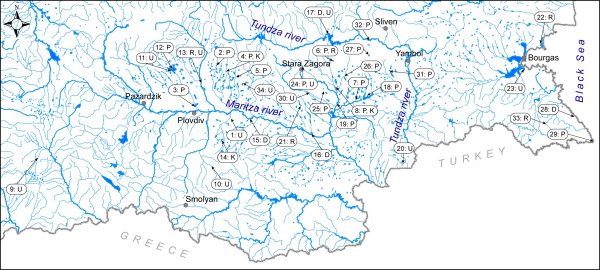 |
Figure 1. Location of the study site (click for larger version)
Legend: P-poaching, R-road kill, D-drowning, K-killing by dogs, U-unknown cause |
| 1 |
Pub in Popovitza village |
18 |
Ovcharitza Dam |
| 2 |
Microdam near Otetz Paisievo village |
19 |
Microdam near Risimanovo village |
| 3 |
Fish-farms in Plovdiv Town |
20 |
River near Sladun village |
| 4 |
Microdam near Zlatosel village |
21 |
On the road near Trakia village |
| 5 |
Medium sized river near Brezovo village |
22 |
Pomoriisko Lake |
| 6 |
Microdam near Podslon village |
23 |
Poda Lake |
| 7 |
Microdam near Kovachevo village |
24 |
Microdam and a pet shop in Stara Zagora Town |
| 8 |
Microdam nearmi Daskal Atanasovo village |
25 |
Two microdams near Trankovo village |
| 9 |
Pub in Bansko Town |
26 |
River near Bogdanovo village |
| 10 |
Village of Belitza |
27 |
Microdam near Konyovo village |
| 11 |
Pub at Piasachnik Dam |
28 |
Black Sea near Tzarevo Town |
| 12 |
Pyasachnik Dam |
29 |
Black Sea near Rezovo village |
| 13 |
On the road and near a river, Rajevo Konare village |
30 |
Pub in Streletz village |
| 14 |
Microdam near Konush village |
31 |
Microdam near Roza village |
| 15 |
Maritza River near Parvomay Town |
32 |
Tundza River near Zlati Voivoda village |
| 16 |
Maritza River near Zlato Pole village |
33 |
On the road to Malko Tarnovo Town |
| 17 |
Jrebchevo Dam |
34 |
Near village of Choba |
RESULTS
Types of otter mortalities
 |
| Figure 2 . Causes of otter mortality recorded in southern Bulgaria, represented as a percent of occurrence |
Poaching (Figure 2, Figure 4) was the most common cause of death recorded in this study (n = 26; 52% of all mortalities recorded). The same problem exists in neighbouring Romania (Csaba and Attila, 2005), in contrast with data from western countries like Germany (Hauer et al., 2002) where the impact of poaching is very low.
Road kill (Figure2, Figure 5) had a relatively low impact (n = 5; 10% of all mortalities), compared with western countries where it is the major cause of death, such as in Germany (Hauer et al., 2002), France (Lafontaine, 1993) and Great Britain (Kruuk and Conroy, 1991; Simpson, 1997; Chanin, 2003).
Drowning in fish-nets also had a low impact (n = 4; 8% of all mortalities) which is similar to data for Germany (Hauer et al., 2002) while in some regions of France it is a critical factor (Lode, 1993).
Killing by dogs had the lowest impact recorded (n = 3; 6% of all mortalities). A low percent of this mortality type was also reported for England (Simpson, 2002). 12% (n = 6) of the cases were of illegal possession of taxidermic specimens (Figure 7) or otter pelts; illegal killing can be assumed but is not proven. For an additional 12% (n = 6) the cause of death was entirely unknown (Figure 6).
Distribution of otter deaths by habitat type
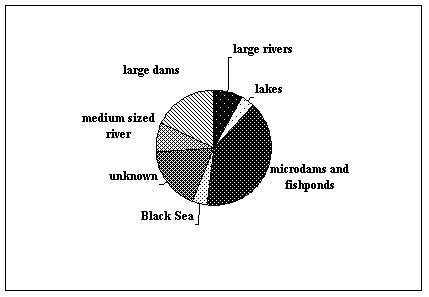 |
| Figure 3 .
Distribution of otter mortalities between various habitats of southern Bulgaria. |
Micro-dams and fishponds: Most of the otter mortalities (n = 20; 40%) came from areas with fish-farming activities, where poaching is a constant non-controllable factor. Most of the otters killed were from the micro-dams used for fish-farming (38% of all mortalities, n = 19 and 57.7% of all illegal killings, n = 15). The mortalities recorded were: 16 individuals killed by poachers (32%), three killed by dogs (6%) and one road casualty (2%).
Large Dams came in second place with 18% (n = 9) of all otter mortalities. The cause of death of the individuals recorded were: one taxidermic specimen (2%), two from unknown causes (4%), one from drowning (2%), and five from poaching (10%).
Large Rivers: Two otters (4%) were killed by poachers and two were drowned in a fyke net, adding up to four dead otters (8%).
Medium-Sized Rivers: Two otters (4%) were killed illegally and two of the mortalities were from unknown causes. Total mortalities = 4 (8%).
Lakes: One road kill (2%) and one unknown cause of death. Total mortalities = 2 (4%).
Black Sea: One drowning (2%) and one illegally killed individual. Total mortalities = 2 (4%).
Unknown location: Five taxidermic specimens (10%), three road casualties (6%), one unknown cause of death (2%). Total mortalities = 9 (18%).
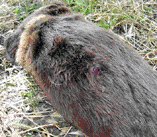 |
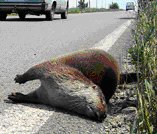 |
| Figure 4. An otter shot by poachers at a micro dam of Podslon village. Photo: D. Georgiev. |
Figure 5. A road kill near Trakia village Photo: A. Mechev |
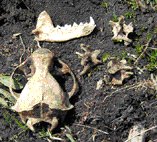 |
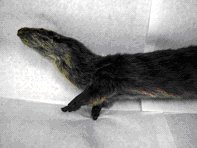 |
| Figure 6. Unknown cause of death: otter bones found near Ovcharitza Dam. Photo: D. Georgiev |
Figure 7. An otter taxidermic mount confiscated by the Regional Environmental Inspection in a pub in Popovitza village. Photo: D. Georgiev. |
CONCLUSIONS AND RECOMMENDATIONS
The most significant cause of death recorded for the otter in southern Bulgaria was poaching as a consequence of present gaps in the national conservation policy. Accordingly, we recommend a control on the microdam fish-farms by the Regional Environmental Inspections and a control on the illegal possession or sale of otters and their derivatives (e.g. pelts).
ACKNOWLEDGMENTS - I would like to thank the following for the useful information on the otter mortalities: Georgi Dulev, Genko Klisurov, Georgi Dilovski, Georgi Stoyanov, Aleksander Mechev, Gradimir Gradev, Stefan Kjurkchiev, Jivko Jelev, Ivailo Klisurov, Ivailo Trifonov, Ivailo Dimchev, Ilian Stoev, Elena Tilova, Jordan Koshev, Mladen Angelov and Svetlana Valchanova. Between March and October 2006, the study in Rhodopes Mountain was financed by the Scientific and Applied Activities Section of the Scientific Research Fund of Plovdiv University “Paisii Hilendarski”. I thank Slaveya Stoycheva for preparing the map of the study area.
REFERENCES
Chanin, P. (2003). Ecology of the European Otter. Conserving Natura 2000 Rivers Ecology Series № 10р English Nature, Peterborough.
Csaba, D. and Attila, K. (2005). Carnivores and humans. Can they peacefully exist in Romania? “Mylvus Group”, Royal Netherlands Embassy, 89 pp.
Georgiev, D. (2005). Habitats of the otter (Lutra lutra) in some regions of southern Bulgaria. IUCN Otter Spec. Group Bull. 22 (1): 6-13.
Georgiev, D., Koshev, J. (2006). A report on the distribution and the habitats of the otter (Lutra lutra) in Bulgaria, and taking a part in the preparing of a conception of its conservation in the country in the Natura 2000 network. Ministry of the Environment and waters, Bulgaria, 17 pp. [Unpublished].
Hauer, S., Ansorge, H. and Zinke, O. (2002). Mortality patterns of otters (Lutra lutra) from eastern Germany. J. Zool. Lond. 256: 361-368.
Kruuk, H. and Conroy, J. (1991). Mortality of otters in Shetland. Journal of Applied Ecology 28: 83-94.
Lafontaine, L. (1993). Distribution of Lutra lutra in Brittany and first preventive measures against road traffic. IUCN Otter Spec. Group Bull. 8: 37-39.
Lode, T. (1993). The decline of otter Lutra lutra populations in the region of the Pays de Loire, Western France. Biological Conservation 65: 9-13.
Simpson, V. (1997). Health status of otters (Lutra lutra) in South West England based on post-mortem findings. Veterinary Record 141: 191-197.
Simpson, V. (2002). Dental lesions and bite wounds in Eurasian Otters (Lutra lutra). In: European Association of Zoo- and Wildlife Veterinarians (EAZWV) 4th scientific meeting, joint with the annual meeting of the European Wildlife Disease Association (EWDA), May 8-12, 2002, Heidelberg, Germany.
Spiridinov, G. and Spassov, N. (1989). The otter (Lutra lutra L., 1758) in Bulgaria, its statе and conservation. Historia naturalis bulgarica 1: 57-63.
Spiridinov, G., Mileva, L. (1994). The status of the otter (Lutra lutra) in Bulgaria. In: Seminar on the Conservation of the European Otter (Lutra lutra), Leeuwarden, the Netherlands, 7-11 June 1994. Pp. 77-80. Council of Europe, Strasbourg.
Résumé : Mortalite De La Loutre D’europe (Lutra Lutra L.) Dans Le Sud De La Bulgarie : Une Etude De Cas
La mortalité de la loutre (n=50) dans le sud de la Bulgarie fut analysée. Dans cette étude, le braconnage fut la cause principale de mortalité (52% des cas), suivi par les collisions routières (10%) et la noyade (8%). Les attaques par des chiens n’eurent qu’un impact mineur (6%).
La plupart des carcasses provinrent de secteurs à activité piscicole – micro barrages et étangs de pisciculture. En seconde position, vinrent les régions où se trouvent de grands barrages, avec 18 % des carcasses. Peu de carcasses provinrent des autres régions.
Revenez au dessus
Resumen: Estudio Sobre La Mortalidad De La Nutria De Rio (Lutra Lutra L.) En El Sur De Bulgaria
La mortalidad de la nutria de río (n=50) fue analizada en el sur de Bulgaria. Entre los diferentes tipos de mortalidad, las muertes debidas a cazadores furtivos fue la causa más común en este estudio (52%), seguida por muertes debidas a atropellamientos por vehículos (10%) y ahogadas (8%). Nutrias muertas como consecuencia de ataques de perros tuvo el impacto más bajo (6%).
La mayoría de las nutrias de río muertas provinieron de áreas con producción piscícola, pequeñas represas y estanques con peces. Áreas con estanques grandes tuvieron menos mortalidad con sólo un 18%. Otras áreas tuvieron menor número de nutrias de río muertas.
Vuelva a la tapa
Previous | Contents | Next
|








